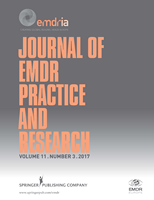
A Working Memory Explanation for the Effects of Eye Movements in EMDR
Research has consistently demonstrated that performance is degraded when participants engage in two simultaneous tasks that require the same working memory resources. This study tested predictions from working memory theory to investigate the effects of eye movement (EM) on the components
of autobiographical memory. In two experiments, 24 and 36 participants, respectively, focused on negative memories while engaging in three dual-attention EM tasks of increasing complexity. Compared to No-EM, Slow-EM and Fast-EM produced significantly decreased ratings of image vividness, thought
clarity, and emotional intensity, and the more difficult Fast-EM resulted in larger decreases than did Slow-EM. The effects on emotional intensity were not consistent, with some preliminary evidence that a focus on memory-related thought might maintain emotional intensity during simple dual-attention
tasks (Slow-EM, No-EM). The findings of our experiments support a working memory explanation for the effects of EM dual-attention tasks on autobiographical memory. Implications for understanding the mechanisms of action in EMDR are discussed.
Keywords: EMDR; EYE MOVEMENTS; MECHANISMS OF ACTION; MEMORY COMPONENTS; WORKING MEMORY
Document Type: Research Article
Publication date: 01 November 2008
- The Journal of EMDR Practice and Research is no longer available to subscribers on Ingenta Connect. Please go to http://connect.springerpub.com/content/sgremdr to access your online subscription to Journal of EMDR Practice and Research.
- Access Key
- Free content
- Partial Free content
- New content
- Open access content
- Partial Open access content
- Subscribed content
- Partial Subscribed content
- Free trial content